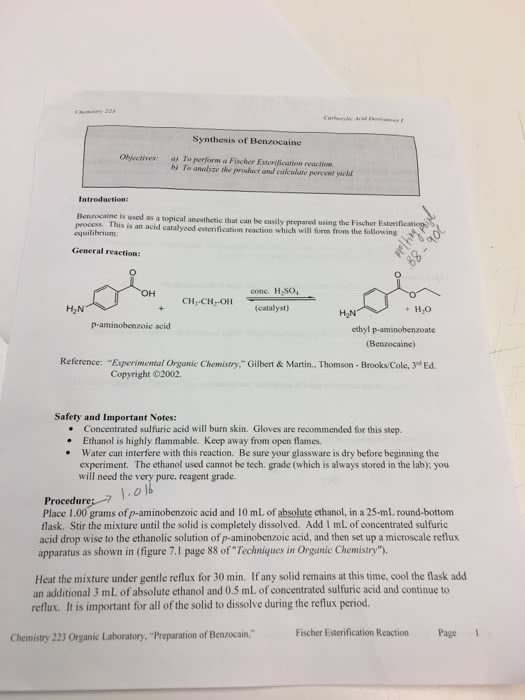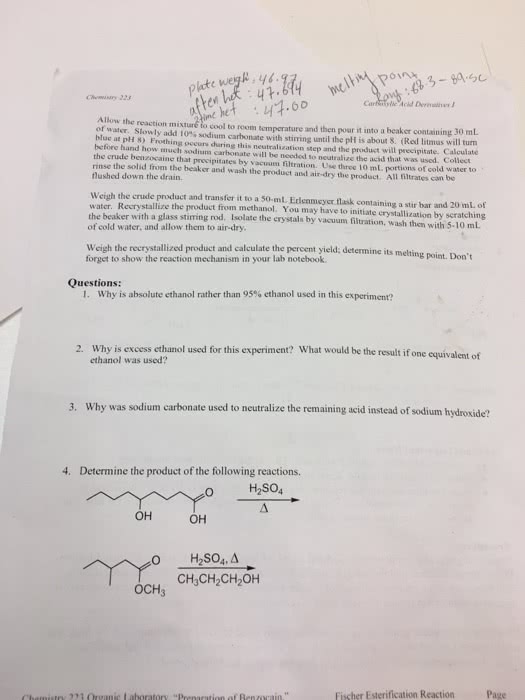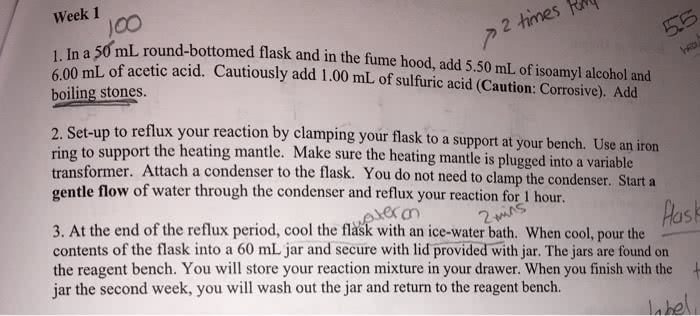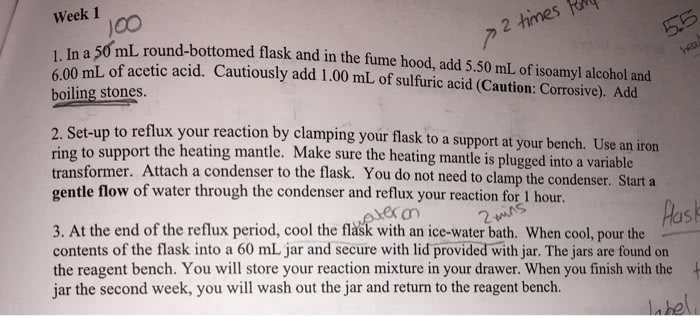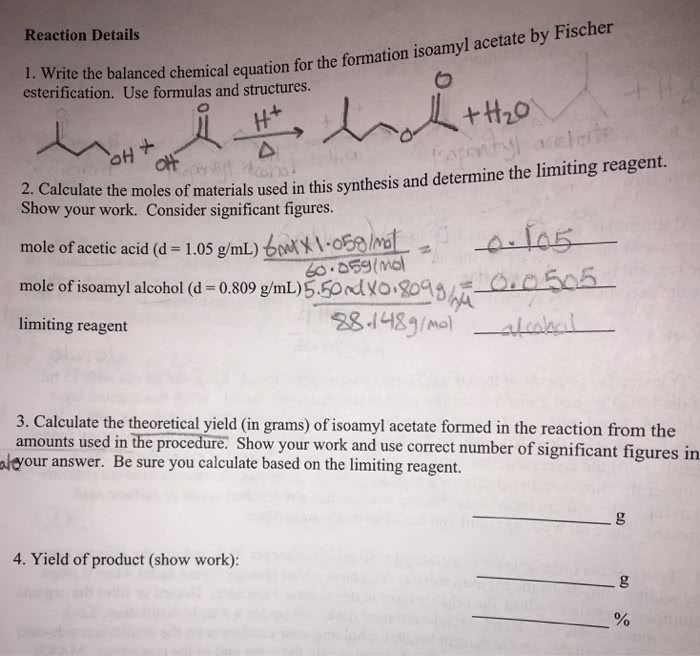Procedure: Setting Up: Add 1.0 g of p-aminobenzoic acid and 10 mL of absolute ethanol to the round-bottom flask containing a stir bar. Stir the mixture until the solid is completely dissolved. Add 1 mL of concentrated [18M] sulfuric acid dropwise to the ethanolic solution of p-aminohenzoic acid, equip the flask with a condenser, and set up the apparatus for heating under reflux using the heating mantle. Reaction: Heat the mixture under gentle reflux for 30 min, stirring all the while. If any solid remains in the flask at this time, remove the flask from the heat source and allow the mixture to cool for 2-3 min. Add an extra 3 mL of ethanol and 0.5 mL of concentrated H2SO4, to the reaction flask and resume heating under reflux. After the reaction mixture becomes homogeneous, continue heating it under gentle reflux for another 30 min. For the experiment to succeed, it is important that all of the solids dissolve during the reflux period. Work-Up and Isolation: Allow the reaction mixture to cool to room temperature and then pour it into a beaker containing 30 mL of water. Basify the mixture to a pH of about 8 by slowly adding 10% aqueous sodium carbonate with stirring. Be careful in this step as frothing occurs during the neutralization. You should calculate beforehand the approximate volume of 10% aqueous sodium carbonate that will be required to neutralize the total amount of sulfuric acid you used. Collect the crude benzocaine that precipitates by vacuum filtration. Use three 10-mL portions of cold water to rinse the solid from the beaker and wash the filter cake. Air-dry the product. Purification: Weigh the crude product and recrystallize from methanol/water pair of solvents: Place the solid in a 50 mL Erlenmeyer flask. Add the minimum amount of hot methanol to dissolve it. Keep on a steam bath. Slowly add hot water to the solution using a disposable pipette just until the solution becomes cloudy and fails to clear up when it is swirled. To the hot solution on the steam bath add hot methanol, drop wise, until the turbidity or crystals just disappear. Allow the solution to cool to room temperature and then cool it in an ice-water bath for 10-15 min to complete crystallization. Isolate the crystals by vacuum filtration, wash them with 5-10 mL of cold water, and allow them to air-dry. Weigh the crystals and calculate the percentage yield.
True or False? When analyzing the IR spectra of starting material and product, a positive indication suggesting that the product was made would be the disappearance of a strong stretch between 1690-1740 cm-1.
True False
Why is it important that all of the solids dissolve during the reflux period for you to obtain a good yield of product?
A. Because everything needs to be in solution for the reaction to happen to the fullest extent.
B. Because the product will be impure if the intermediate doesn't dissolve completely.
C. Because the ethanol will evaporate off if it's not dissolved.
D. All of the above
What is the gas that is evolved during neutralization?
A. O2
B. CO2
C. SO2
D. CO3
Why is it necessary to neutralize the reaction mixture to work up the product?
A. Because it is dangerous to work with an acidic solution.
B. Because after the addition of ethanol and sulfuric acid, the benzocaine exists as ammonia and must be protonated so that it becomes insoluble and collectable.
C. Because after the addition of ethanol and sulfuric acid, the benzocaine exists as a soluble carboxylic acid and must be neutralized so that it becomes insoluble and collectable.
D. Because after the addition of ethanol and sulfuric acid, the benzocaine exists as a soluble ammonium salt and must be neutralized so that it becomes insoluble and collectable.
If you end up adding 1.5 mL of concentrated sulfuric acid (18 M), how many mL of 10% aqueous sodium carbonate would be required to neutralize the reaction mixture?
A. 1.5 mL
B. 3 mL
C. 15 mL
D. 29 mL
What is the purpose of the sulfuric acid?
A. To catalyze the reaction.
B. To protonate the intermediate salt.
C. To protonate the ethanol.
D. To increase the pH of the reaction mixture.
What is the theoretical yield of the product?
A. 1.00 g
B. 2.98 g
C. 1.20 g
D. 10 mL
Procedure: Setting Up: Add 1.0 g of p-aminobenzoic acid and 10 mL of absolute ethanol to the round-bottom flask containing a stir bar. Stir the mixture until the solid is completely dissolved. Add 1 mL of concentrated [18M] sulfuric acid dropwise to the ethanolic solution of p-aminohenzoic acid, equip the flask with a condenser, and set up the apparatus for heating under reflux using the heating mantle. Reaction: Heat the mixture under gentle reflux for 30 min, stirring all the while. If any solid remains in the flask at this time, remove the flask from the heat source and allow the mixture to cool for 2-3 min. Add an extra 3 mL of ethanol and 0.5 mL of concentrated H2SO4, to the reaction flask and resume heating under reflux. After the reaction mixture becomes homogeneous, continue heating it under gentle reflux for another 30 min. For the experiment to succeed, it is important that all of the solids dissolve during the reflux period. Work-Up and Isolation: Allow the reaction mixture to cool to room temperature and then pour it into a beaker containing 30 mL of water. Basify the mixture to a pH of about 8 by slowly adding 10% aqueous sodium carbonate with stirring. Be careful in this step as frothing occurs during the neutralization. You should calculate beforehand the approximate volume of 10% aqueous sodium carbonate that will be required to neutralize the total amount of sulfuric acid you used. Collect the crude benzocaine that precipitates by vacuum filtration. Use three 10-mL portions of cold water to rinse the solid from the beaker and wash the filter cake. Air-dry the product. Purification: Weigh the crude product and recrystallize from methanol/water pair of solvents: Place the solid in a 50 mL Erlenmeyer flask. Add the minimum amount of hot methanol to dissolve it. Keep on a steam bath. Slowly add hot water to the solution using a disposable pipette just until the solution becomes cloudy and fails to clear up when it is swirled. To the hot solution on the steam bath add hot methanol, drop wise, until the turbidity or crystals just disappear. Allow the solution to cool to room temperature and then cool it in an ice-water bath for 10-15 min to complete crystallization. Isolate the crystals by vacuum filtration, wash them with 5-10 mL of cold water, and allow them to air-dry. Weigh the crystals and calculate the percentage yield.
True or False? When analyzing the IR spectra of starting material and product, a positive indication suggesting that the product was made would be the disappearance of a strong stretch between 1690-1740 cm-1.
|
Why is it important that all of the solids dissolve during the reflux period for you to obtain a good yield of product?
A. Because everything needs to be in solution for the reaction to happen to the fullest extent.
B. Because the product will be impure if the intermediate doesn't dissolve completely.
C. Because the ethanol will evaporate off if it's not dissolved.
D. All of the above
What is the gas that is evolved during neutralization?
A. O2
B. CO2
C. SO2
D. CO3
Why is it necessary to neutralize the reaction mixture to work up the product?
A. Because it is dangerous to work with an acidic solution.
B. Because after the addition of ethanol and sulfuric acid, the benzocaine exists as ammonia and must be protonated so that it becomes insoluble and collectable.
C. Because after the addition of ethanol and sulfuric acid, the benzocaine exists as a soluble carboxylic acid and must be neutralized so that it becomes insoluble and collectable.
D. Because after the addition of ethanol and sulfuric acid, the benzocaine exists as a soluble ammonium salt and must be neutralized so that it becomes insoluble and collectable.
If you end up adding 1.5 mL of concentrated sulfuric acid (18 M), how many mL of 10% aqueous sodium carbonate would be required to neutralize the reaction mixture?
A. 1.5 mL
B. 3 mL
C. 15 mL
D. 29 mL
What is the purpose of the sulfuric acid?
A. To catalyze the reaction.
B. To protonate the intermediate salt.
C. To protonate the ethanol.
D. To increase the pH of the reaction mixture.
What is the theoretical yield of the product?
A. 1.00 g
B. 2.98 g
C. 1.20 g
D. 10 mL

